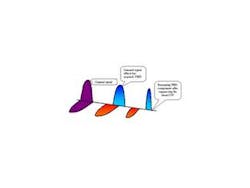Future wave in optical network monitoring
A new technology enables true-OSNR measurement through in-channel monitoring techniques.
By OPHIR SHALITIN, GAL SHABTAY, and ZEEV ZALEVSKY, Civcom--Today optical performance monitors (OPMs) and optical spectrum analyzers (OSAs) are commonly deployed in optical networks, usually embedded within terminal or node equipment. While these devices can measure a variety of optical parameters such as channel wavelength and optical power to assess network performance, more traditional measurements from the TDM and SONET/SDH world, such as bit-error rate (BER), still prevail. A BER measurement can serve as a quality-of-service (QoS) indicator, but used alone, it does not indicate the type or location of a fault, or alert network operators to a degrading network element.
Another measurement, optical signal-to-noise ratio (OSNR), more accurately assesses signal quality in the optical domain. Current implementations of OSNR use out-of-band measurement techniques (i.e. in-between optical channels) however, which risk impairment by channel crosstalk, filters, or demultiplexers along the optical path. Furthermore, conventional OSAs can misestimate the signal power of modulated channels because modulation sidebands impair measurement accuracy. True OSNR of live signals is therefore impossible to measure in DWDM networks by conventional (out-of-band) means.
While network monitoring is important at all nodes, the required measurements vary depending on the type of node and network. In DWDM terminal nodes where signals are generated (i.e. ingress), wavelength drift monitoring may be necessary as well as verification that all channels operate smoothly. At the other end of the network (i.e. egress node), it is desirable to measure the characteristics of optical channels in order to assess signal quality along the transmission path, and perhaps indicate an early warning whenever the optical signal starts to degrade. In erbium-doped fiber amplifier (EDFA) nodes, the transmission optical spectrum is important for verifying channel optical powers and measuring amplifier-spontaneous-emission (ASE) noise, an inevitable consequence of using EDFAs.
Two measurements better than one
A combination of BER and OSNR measurements yields the most complete signal metrics. While BER indicates the overall signal quality, OSNR tracks subtle changes, providing more detailed information on the source of the problem. Moreover, OSNR measurement can be cost-effectively applied in all-optical nodes where no electronic conversion occurs, or when only a few of the wavelengths are converted, while most pass through.
Although OPMs provide reasonable means to monitor optical networks in lightly loaded systems, as these infrastructures become heavily loaded, the limitations of these devices become evident. The trend towards the use of densely populated channel grids requires finer optical resolution. Channel power is perhaps the easiest metric to capture; but when it comes to measuring OSNR by conventional (i.e. out-of-band) means, only out-of-band non-signal noise can be measured. Measuring noise in a spectral region that does not overlap with the channel becomes increasingly complicated as DWDM channels are more tightly spaced. Precise measurements on grid spacing of 50 GHz or less are truly challenging.
In long-haul or ultra-long-haul networks with optical add/drop multiplexers (OADMs), channels may traverse through a different number of EDFA nodes. Even adjacent channels, therefore, may experience a significantly different noise level. When optical networks become more dynamic and transparent, and carriers begin to deploy reconfigurable OADMs, this variance in OSNR in adjacent channels will be further exacerbated. Naturally, different noise levels between adjacent channels can impair the accuracy of the out-of-band measurement that gauges the noise between pairs of adjacent channels (see Figure 1a).
When channels traverse through filters or demultiplexing apparatus, these devices strongly suppress, and essentially slice out, the spectral regions beside (and between) channels. In such cases a meaningless, very low, OSNR may be measured out-of-band (between channels) regardless of the true OSNR level (see Figure 1b).
Polarization nulling technology
To overcome this limitation, a new technology called polarization nulling, which is based on the different polarization attributes of the noise and signal, comes into play. When EDFAs amplify incoming optical signals, ASE noise is unavoidably inserted into the optical channels. Interestingly, ASE noise is essentially "white noise," which is unpolarized, while the actual channel signals exhibit high degrees of polarization (DOPs). The DOP of each channel, defined as the ratio of the polarized power to the total power, depends upon the level of ASE noise and hence the "true OSNR." Half of the ASE power can be extracted as long as the polarization mode dispersion (PMD) is insignificant, by applying polarization modulation via a polarization controller to the composite signal (composed of the channel signal and the ASE), and then using a linear polarizer.
In many cases, however, the PMD is not negligible. It then affects the DOP independently of the OSNR. In such a case polarization nulling is not enough to derive the true OSNR. PMD effectively causes the signals to be "smeared" in time so that minimizing a certain state of polarization (SOP) still leaves the SOP beside it not completely suppressed (see Figure 2).
In order to overcome the limitations imposed by PMD, a more sophisticated method has to be implemented. By replicating the signals with each replica having different amplitude with short and well-defined intervals between the replicas, a finite impulse response (FIR) filter is essentially synthesized. Correctly setting the amplitude of each replica, and the delay between adjacent replications, generates a filter that suppresses the main signal while leaving a constant residual energy in the replications for the PMD constituents of the signals that are not suppressed. Two PMD constituents remain; one on each side of the suppressed signal (see Figure 2). When no polarization dependent loss is present, these constituents maintain a complementary energy level equal to a constant level. After polarization rotation and filtering, one constituent is rotated to a SOP that is further blocked by the polarizer while the other orthogonal constituent passes to the extent it complements the energy to the constant level. The constant constituent is easily cancelled, while the remaining variable constituent is attributed to the ASE.
With this method a PMD-agnostic true-OSNR measurement is enabled. By providing precise estimation of amplifier noise, true OSNR enables preventative maintenance for problems generated by faulty pumps or network elements inducing excessive noise.
All in all, this emerging technology will serve as a fundamental enabler of all-optical networks where channel power varies across the network and signals traverse multiple nodes. To render these transparent networks cost-effective, there has to be an affordable way to gauge network health accurately at the optical level. Non-linear effects measurement still need to be addressed to complete the picture, but these are secondary parameters of lesser importance. In the next generation of more transparent networks, BER complemented by true-OSNR measurements will deliver the final QoS gauge as well as means for early warning and troubleshooting.


